Initial Conditioning
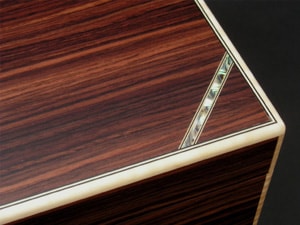
Do not spray the interior of any humidor with water or apply a damp sponge or wet rag to any interior surface. This will only cause the wood to expand rapidly and will raise the grain of the wood thereby giving it a rough texture. It could also cause the interior side walls to split apart and the lid to warp. We will not honor any repair on humidors that have been over -saturated with water. Please read carefully our Humigar™ instruction sheet. Be patient and go slowly while conditioning the humidor to the 70% R.H. level. It is a slow process and needs to be done slowly so that the box can acclimate to the higher humidity levels. A bowl of tap water may also be placed in the bottom of the humidor to expedite this process. Fill the Humigar™ moisturizer as well with the distilled water through the front vents.
Construction Process
All humidors have to be laminated or layered using solid hardwoods, MDF(Medium Density Fiberboard), and wood veneers. Glue dries harder than wood and stabilizes it. MDF is very stable and will not warp. Tempered hardboard is even more dense and will not warp. Exterior surfaces are covered in sawn veneer as well as regular veneer. If built properly, humidors can hold the 70% moisture inside that is required to keep cigars moist without warping. The lids on solid hardwood humidors most likely will warp over time. This is due to the grain structure of the solid wood that follows the growth rings of the tree which is round.
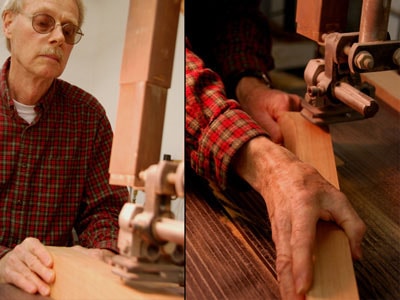 A second reason for using the above laminated construction method is the availability of decorative/exotic woods. These are almost always available in veneer form only. They are environmentally friendly, available in small quantities, and are of high quality. You will not see these unusual, highly decorative species of woods in any other wood products on the marketplace today. Quilted Cherry, Lightning Bolt Movingue, Curly Koa, and Beeswing Eucalyptus are some of the species sold one log at a time. Some are so unusual in grain structure that they are one-of-a-kind and will not ever be available again. They are not going extinct nor are they endangered but simply have an unusual grain pattern on one tree only which shines out above all the rest. And these are what you feast your eyes on when you go to our website to visit them. You are beholding the rare and natural beauty of what the wood world has to offer!
A second reason for using the above laminated construction method is the availability of decorative/exotic woods. These are almost always available in veneer form only. They are environmentally friendly, available in small quantities, and are of high quality. You will not see these unusual, highly decorative species of woods in any other wood products on the marketplace today. Quilted Cherry, Lightning Bolt Movingue, Curly Koa, and Beeswing Eucalyptus are some of the species sold one log at a time. Some are so unusual in grain structure that they are one-of-a-kind and will not ever be available again. They are not going extinct nor are they endangered but simply have an unusual grain pattern on one tree only which shines out above all the rest. And these are what you feast your eyes on when you go to our website to visit them. You are beholding the rare and natural beauty of what the wood world has to offer!
Finally, if you really want to see the entire construction process of our humidors as well as pictures taken during the process, go to our website michaeldixonhumidors.com and click onto Facebook/shop tour.
Bottom Construction - Recessed vs. Flush
There are two methods of constructing the bottom of a humidor, or any box for that matter. The first is a flush bottom method which is flat on the bottom. Most boxes use plywood for the bottom. A flush bottom has to be fitted and stapled and glued into place so it will not come apart. However this method has two distinct disadvantages. If the plywood bows or warps, the bottom will become curved and will not sit flat on a flat surface. Also it is structurally weak compared to the recessed/drawer bottom method. You could actually punch out the bottom of a box with your fist or hammer as the plywood is only attached to a very small area of the side walls.
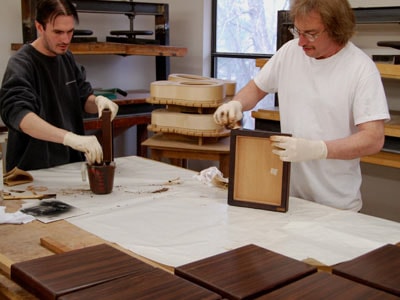 The second method is the recessed bottom whereby the plywood bottom is recessed into a locking dado groove usually ¼” above the bottom surface. Most drawer bottoms are constructed in this manner. It is a much stronger method of construction and will not be affected by a warped plywood bottom. We use this recessed method only.
The second method is the recessed bottom whereby the plywood bottom is recessed into a locking dado groove usually ¼” above the bottom surface. Most drawer bottoms are constructed in this manner. It is a much stronger method of construction and will not be affected by a warped plywood bottom. We use this recessed method only.
Interior Woods - Sapele vs. Spanish Cedar
Spanish Cedar has been used this century and the last for cigar box construction. It has always been the wood of choice for curing and aging cigars. Perhaps the aroma of Cedar blends with the tobacco and helps to enhance its aroma. It is definitely a tradition that is steeped in the history of cigar making itself. Perhaps one of the reasons it was used initially was because of its availability at the time. It is a dominant Latin American specie and literally grows in all the countries from Mexico to Chile. The only exception is Argentina which is too temperate to sustain its growth cycle. In any event it is still preferred by cigar manufacturers for making the boxes that hold the cigars. Note that these are not humidors. They are not sealed and have no moisturizer in them. They are usually a very cheap box covered in a decorative paper.
Also during the aging and curing process of the tobacco leaves, Cedar is used in the storage containers and on the interior walls of warehouses. However, in spite of the above, Cedar has a fatal flaw that makes it an unacceptable wood for long term storage in a cigar humidor. Cedar has a tendency to bleed a sap/gum resin when exposed to the slightest amount of heat. This gummy resin is actually inside the wood itself and may not surface for several months. But when the heat is turned on in winter or the humidor is put near a window with intense sunlight, the gummy beast will come out from hiding beneath the wood surface. So in order to avoid this potential problem we use African Sapele which does not have the resin and is much denser and more stable than Cedar - and - actually smells very close to the Cedar aroma. So it is a far better wood to use in all of the interior surfaces and many humidor makers have discovered this as well.
Hygrometers - Digital vs. Dial
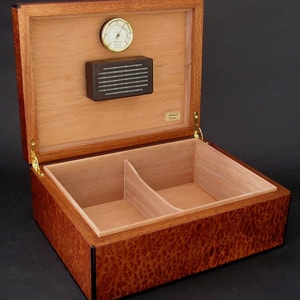 There are two types of hygrometers on the market today - digital and dial. Both have advantages and disadvantages. Dial types are more attractive and most often less expensive, but less accurate, as they have to be calibrated or reset periodically, much like adjusting bathroom scales. Digital types are less attractive, are seldom used by humidor makers, but are more accurate and do not need to be reset. They are most often sold as an aftermarket item and are more expensive than the dial types.
There are two types of hygrometers on the market today - digital and dial. Both have advantages and disadvantages. Dial types are more attractive and most often less expensive, but less accurate, as they have to be calibrated or reset periodically, much like adjusting bathroom scales. Digital types are less attractive, are seldom used by humidor makers, but are more accurate and do not need to be reset. They are most often sold as an aftermarket item and are more expensive than the dial types.
The main problem with hygrometers is not the hygrometer itself, but what it is reading or measuring. Relative humidity is not a constant. It varies from one day to the next, one hour to the next, one minute to the next, and from one side of the room to the other. Think of humidity as a cloud that is full of floating moisture. Much like the clouds outside, it is constantly changing, moving, evaporating, and absorbing moisture. Any attempt to measure this moving moisture is almost impossible, so we have to settle for a range effect and not an exact percentage. Inside a cigar humidor, moisture will always be the highest directly under the moisturizer, and the lowest the furthest away. If there is a tray blocking the movement of the moisture, then the RH could be 70% on the top and 50-60% on the bottom of the humidor, simply because moisture falls as it does from the sky in the form of rain. So even though your hygrometer is reading exactly 70% - don’t trust it - digital or dial.
The best test is to pinch your cigars. The old pinch test will tell you immediately which cigars are OK and which ones are too dry. Use your hygrometer as an indication of range of humidity and try to keep it around the 70% mark. If you still have dry cigars, place them directly under the moisturizer to rejuvenate them.
Moisturizers - Active vs. Passive
There are two types of moisturizers on the market today - active and passive. Both are used in different applications. Active ones are for larger sized humidors as well as humidor chests and cabinets. They have an electronic fan, LED control screen and electronic hygrometer to measure and adjust the humidity levels. They also have a reservoir of water emerged in Oasis floral foam. They plug into an electrical outlet and have a very thin ribbon cable attached to the unit which goes out the rear of the humidor. The most popular brand is Cigar Oasis which can be bought on their website or from Amazon.com.
For smaller desk top type humidors such as we make, the passive style is the most popular. These units are magnetized, attach to the inside lid and evaporate moisture down onto the cigars below. Both active and passive moisturizers have to be refilled with distilled water which will not clog up the floral foam. They are sized in cubic inches to match the interior humidor size in cubic inches. This is important. A small moisturizer will not give off enough moisture to keep the inside of a large humidor at 70%. And a larger unit placed in a small humidor will over saturate the cigars.
Our Humigar™ moisturizers have several important features that make them one of the best on the market. They are designed to fit 3 or 4 of the most popular size humidors from small to large. They also have very strong rare earth magnets to firmly hold them in place. The stainless steel screws on the rear back plates are easily removed in order to replace the foam every year or so. Note: Floral foam has a life span and needs to be replaced most often annually. Finally, our Humigars™ have a plastic screen installed to keep the foam from flaking off onto the cigars.
Trays and Why They Do Not Work
The reason why trays do not work in humidors is very logical. Trays prevent the flow of moisture from falling evenly on the cigars below the tray, and they over-saturate the cigars in the tray that sit immediately below the moisturizer. If you remove the cigars from the tray and allow the moisture to flow evenly through the tray bottom vents, you have defeated the purpose of the tray! What that purpose is we really do not know. So why bother? Exactly! Don’t be duped by humidors with trays, especially the large flashy European brands. They are all show and no go.
Side Rail Hinges and Lock & Key Sets
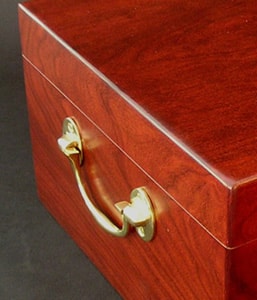
Probably the most frustrating part of making fine quality boxes, be they jewelry boxes, silverware boxes or humidors, is finding good quality hardware, i.e. hinges and lock sets to compliment the quality of the box. There are plenty of junk, low-end hardware suppliers out there today and most of their hardware is being made in Asia.
High quality hardware has to be made from solid brass which tarnishes over time and especially if it is exposed to moisture. So the brass has to be plated but before that, it has to be polished.
There are 3 different processes involving 3 different manufacturers, machinists, polishers, and platers, that are involved in making our hardware. The end product is hinges that are 1/8” thick. They have to be machined several times to make the complicated design we use in our side rail hinges. They are then polished, gold plated and epoxy coated to protect the gold plating. Quite a lengthy process - a three month process to be exact. But the end product is spectacular. Since we design and control the manufacturing of our hinges and lock sets, we have the best hardware of any humidor or box available today.
Finishes - Gloss vs. Semi-Gloss
Have you ever noticed that the high gloss flashy, expensive humidors all come from Europe, and especially France and Italy? This is because the Europeans in general, and the Italians in particular, like high gloss finishes on their wood products - jewelry boxes, music boxes, furniture, etc. High gloss finishes have always been more popular in Europe than in the U.S. where more traditional designs and finishes are the mode. The problem with high gloss finishes is twofold. First, they are very labor intensive, requiring 3 times more labor than a semi-gloss finish. The material costs are 5 times the cost of semi-gloss lacquer, they require 8 to10 coats vs. 2 to 3 coats of semi-gloss, and they must be wet sanded and hand buffed on buffing wheels to get that shiny, wet look. Second, gloss finishes scratch very easily and any small scratch is easily seen, making a humidor with gloss finish very difficult to maintain in perfect condition. So we say again, “ Why bother? “ We prefer the softer, more natural look of a semi-gloss finish which shows the beauty of the wood grain and figure much better. Also the scratches are not as easily seen and are much easier to repair
If you already own a Michael Dixon Humidor,
here are a few tips for you:
Why Cigars Need Humidity
The best cigars today are made from tobacco grown in tropical Cuba, the Dominican Republic, Mexico, and the countries of Central America. The relative humidity in these countries is ideal for maturation of the tobacco leaves. Humidity levels are high (70%-80%), and constant.
Cigars made from tobacco grown in these climates need to be maintained in an environment of controlled humidity and temperature similar to that of the countries where the tobacco is grown. Cigars need their original humid atmosphere to mature properly and allow the cigar to burn cool and produce a pleasant aroma and flavor. (Note: Once a cigar “dries out” it loses its original flavor and will burn hot.)
It is therefore necessary to maintain the humid climate of the original growing area (70%-80% R.H.) when storing the cigars at home or in the office. This can be done by the use of a good quality cigar humidor with a tight seal and a good moisturizing system in order to keep the cigars at their original moisture content (about 13%-14%). If this is done, the cigars will burn smoothly and provide a light pleasant smoke with an easy draw. The aroma will also be at its best. In addition to the above a hygrometer is also needed to measure the humidity levels. Note: Hygrometers only provide an approximate measure of humidity.
The relative humidity inside the humidor should be maintained at about 70%, and when any loss of humidity occurs, it will be necessary to add distilled water only. Distilled water will provide for longevity of the interior foam by preventing build up of minerals found in most tap water. Also over-saturation of the unit should be avoided (80%-90% R.H.) as this causes the cigars to mold and rot after only a few days, especially in drier areas and in the winter months when outside humidity levels are low. In the summer months when humidity levels are high, and in southern states and especially Florida where humidity is high and constant water will be needed less.
Instructions for Using the Michael Dixon Humigar™
The Humigar™ moisturizing system is exclusive to Michael Dixon Humidors. We designed it to provide the ideal humidification system for our humidors. The Humigar ™ contains a block of floral foam which absorbs water and slowly lets it evaporate into the interior of the humidor. This foam absorbs and evaporates the distilled water more efficiently than a glycerin solution.
Cigars are like “mini-sponges”. They absorb moisture but need time to do so. Your humidor needs to be conditioned slowly by adding the proper amount of water to the foam inside the Humigar™. *(See below for recommended amounts .) We recommend replacing the foam once or twice a year. It is easy to replace by taking out the Humigar™, unscrewing the back plate and removing the foam. “Oasis Floral Foam” is available at most craft supply and garden stores. It comes in a “brick” which is easily cut with a sharp knife, and one brick will make several Humigar™ foam replacements..
Recent analysis has indicated that in some instances customers are over-saturating the Humigar™ moisturizers in order to reach the 70% humidity condition in the least amount of time possible. This can cause several problems and harm both your humidor (wood expansion) and cigars (cigar mold). Also the cigars on the top layer closest to the moisturizer will absorb more rapidly than the ones on the bottom. In addition a humidor full of cigars will require more moisture than one that is nearly empty. Ideally the humidor should be kept as full as possible with cigars and rotated occasionally as with fine wines. It is therefore imperative to not over-saturate the Humigar™ moisturizer when initially conditioning your humidor and cigars. It is better to go slowly over a few days time and let the interior acclimate to the new moisture conditions.
We recommend not putting your cigars in the humidor until it is up to the 70% mark. This way the humidor absorbs the moisture slowly. Do not spay or wipe any water with a wet sponge or rag directly onto the interior wood surface. This will cause the wood to expand too rapidly and make the interior Spanish Cedar rough and fuzzy. Additional moisture can be added by putting a bowl of water inside the humidor. Once the hygrometer reads 70%, remove the bowl.
* For our Humigar™ moisturizers we recommend initial treatment as follows:
Michael Dixon Humidor Model:
C #90 Large Humigar 2 oz. of distilled water
E #91 Small Humigar 1 oz. of distilled water
B #93 Medium Humigar 1.5 oz. of distilled water
After a day or two of conditioning add more water as needed until the hygrometer reads approximately 70%.
Mounting the Humigar™ in a Humidor Not Made By Us
Each unit comes with magnets applied to the back side (2 on large Model 90 and 1 on small Model 91). Matching stainless steel plates are to be applied to the top inside lid of the box using self-adhesive tape provided. Note: If additional gluing strength is required, apply a small amount of 5 minute epoxy to the steel plate.




